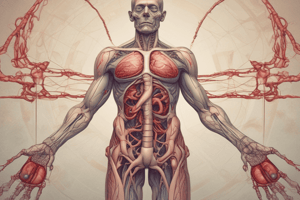Podcast
Questions and Answers
What is the most common site of origin for an embolus causing pulmonary thromboembolism?
What is the most common site of origin for an embolus causing pulmonary thromboembolism?
- Jugular veins
- Pulmonary arteries
- Veins of the calf muscles (correct)
- Veins of the arm
Which of the following is NOT a common cause of embolism?
Which of the following is NOT a common cause of embolism?
- Thrombus
- Platelet aggregates
- Air
- Excessive exercise (correct)
Which patient population has a higher incidence of developing deep venous thrombosis?
Which patient population has a higher incidence of developing deep venous thrombosis?
- Children
- Young athletes
- Pregnant women
- Middle-aged and elderly people (correct)
What percentage of pulmonary thromboembolism cases are asymptomatic?
What percentage of pulmonary thromboembolism cases are asymptomatic?
Which factor does NOT influence the clinical outcome of pulmonary thromboembolism?
Which factor does NOT influence the clinical outcome of pulmonary thromboembolism?
What condition may lead to pulmonary infarction following embolism?
What condition may lead to pulmonary infarction following embolism?
Which term describes a detached mass carried by blood that can obstruct a vessel?
Which term describes a detached mass carried by blood that can obstruct a vessel?
Which outcome is NOT typical in cases of massive pulmonary emboli?
Which outcome is NOT typical in cases of massive pulmonary emboli?
What is one component of Virchow's triad related to changes in blood flow?
What is one component of Virchow's triad related to changes in blood flow?
Which type of thrombus is primarily composed of platelets and fibrin strands?
Which type of thrombus is primarily composed of platelets and fibrin strands?
Which condition is associated with increased platelet quantity and function after surgical procedures?
Which condition is associated with increased platelet quantity and function after surgical procedures?
Which fate of a thrombus involves it dislodging and traveling to other parts of the circulatory system?
Which fate of a thrombus involves it dislodging and traveling to other parts of the circulatory system?
What type of thrombus is typically formed in venous thrombosis?
What type of thrombus is typically formed in venous thrombosis?
What is meant by recanalization in the context of thrombus organization?
What is meant by recanalization in the context of thrombus organization?
Which of the following conditions does NOT directly lead to endothelial injury?
Which of the following conditions does NOT directly lead to endothelial injury?
Which mechanism can lead to infarction following thromboembolism?
Which mechanism can lead to infarction following thromboembolism?
What is the primary difference between a thrombus and an embolus?
What is the primary difference between a thrombus and an embolus?
Which chemical mediator synthesized by endothelial cells inhibits platelet aggregation?
Which chemical mediator synthesized by endothelial cells inhibits platelet aggregation?
What triggers platelet activation during injury to the endothelium?
What triggers platelet activation during injury to the endothelium?
What is the function of thrombin in hemostasis?
What is the function of thrombin in hemostasis?
What is the most common site of impaction for systemic thromboembolism?
What is the most common site of impaction for systemic thromboembolism?
Which factor is primarily responsible for the stabilization of the clot?
Which factor is primarily responsible for the stabilization of the clot?
What type of infarct is typically associated with venous occlusion?
What type of infarct is typically associated with venous occlusion?
What process dissolves a clot during wound healing?
What process dissolves a clot during wound healing?
Which of the following conditions is most likely to lead to systemic emboli?
Which of the following conditions is most likely to lead to systemic emboli?
Which receptor is involved in platelet aggregation through fibrinogen binding?
Which receptor is involved in platelet aggregation through fibrinogen binding?
What describes thrombosis?
What describes thrombosis?
What is the characteristic shape of an infarcted area seen cross-sectionally?
What is the characteristic shape of an infarcted area seen cross-sectionally?
What is a possible clinical consequence of femoral artery occlusion?
What is a possible clinical consequence of femoral artery occlusion?
Which factors contribute to the clinical significance of systemic thromboembolism?
Which factors contribute to the clinical significance of systemic thromboembolism?
Which type of infarcts typically occur in solid organs like the heart and kidney?
Which type of infarcts typically occur in solid organs like the heart and kidney?
What is the primary cause of nearly 99% of all infarcts?
What is the primary cause of nearly 99% of all infarcts?
What is a common clinical presentation of deep venous thrombosis (DVT)?
What is a common clinical presentation of deep venous thrombosis (DVT)?
Which of the following factors significantly influences the clinical outcome of pulmonary thromboembolism?
Which of the following factors significantly influences the clinical outcome of pulmonary thromboembolism?
Which type of embolus is most commonly associated with pulmonary thromboembolism?
Which type of embolus is most commonly associated with pulmonary thromboembolism?
What condition is indicated by pulmonary thromboembolism when the patient's cardiopulmonary status is poor?
What condition is indicated by pulmonary thromboembolism when the patient's cardiopulmonary status is poor?
In which location do most pulmonary thromboembolisms originate?
In which location do most pulmonary thromboembolisms originate?
Which of the following outcomes is least likely to result from a pulmonary thromboembolism?
Which of the following outcomes is least likely to result from a pulmonary thromboembolism?
What is the primary mechanism that leads to the obstruction of a vessel by an embolus?
What is the primary mechanism that leads to the obstruction of a vessel by an embolus?
Which statement regarding pulmonary thromboembolism is most accurate?
Which statement regarding pulmonary thromboembolism is most accurate?
Which of the following factors is related to changes in blood flow that can contribute to thrombus formation?
Which of the following factors is related to changes in blood flow that can contribute to thrombus formation?
What type of thrombus is primarily composed of platelets, fibrin strands, and red blood cells?
What type of thrombus is primarily composed of platelets, fibrin strands, and red blood cells?
What fate of a thrombus is characterized by it dislodging and traveling to obstruct other vessels?
What fate of a thrombus is characterized by it dislodging and traveling to obstruct other vessels?
The process by which endothelial cells ingrow into a fibrin-rich thrombus is known as what?
The process by which endothelial cells ingrow into a fibrin-rich thrombus is known as what?
Which condition is associated with increased blood viscosity that may lead to thrombus formation?
Which condition is associated with increased blood viscosity that may lead to thrombus formation?
What classification describes thrombi that are formed in the presence of pyogenic bacteria?
What classification describes thrombi that are formed in the presence of pyogenic bacteria?
Endothelial injury can occur due to which of the following conditions?
Endothelial injury can occur due to which of the following conditions?
Which outcome of a thrombus is specifically indicated when there is a total obstruction leading to tissue death?
Which outcome of a thrombus is specifically indicated when there is a total obstruction leading to tissue death?
What initiates platelet adhesion during vascular injury?
What initiates platelet adhesion during vascular injury?
Which substance is primarily responsible for the cross-linking of platelets during aggregation?
Which substance is primarily responsible for the cross-linking of platelets during aggregation?
What role does plasmin play during the healing process of a clot?
What role does plasmin play during the healing process of a clot?
What effect does damaged endothelial cells have on platelet activity?
What effect does damaged endothelial cells have on platelet activity?
Which process is directly involved in the conversion of fibrinogen to fibrin?
Which process is directly involved in the conversion of fibrinogen to fibrin?
What characterizes thrombosis in the vascular system?
What characterizes thrombosis in the vascular system?
What initiates the process of fibrinolysis?
What initiates the process of fibrinolysis?
What is the result of decreased binding of prostacyclin to platelet receptors?
What is the result of decreased binding of prostacyclin to platelet receptors?
What primarily causes nearly 99% of all infarcts?
What primarily causes nearly 99% of all infarcts?
Which classification of infarcts is characterized by venous occlusion?
Which classification of infarcts is characterized by venous occlusion?
How are infarcts typically shaped when viewed cross-sectionally?
How are infarcts typically shaped when viewed cross-sectionally?
Which organ is most commonly affected by systemic thromboembolism due to its anatomical characteristics?
Which organ is most commonly affected by systemic thromboembolism due to its anatomical characteristics?
What complicates the implications of infarction in terms of clinical outcomes?
What complicates the implications of infarction in terms of clinical outcomes?
Which of the following best describes a septic infarct?
Which of the following best describes a septic infarct?
What type of emboli is primarily responsible for the most severe outcomes affecting the brain?
What type of emboli is primarily responsible for the most severe outcomes affecting the brain?
Which characteristic defines anemic (white) infarcts?
Which characteristic defines anemic (white) infarcts?
Flashcards
Thrombus vs. Embolus
Thrombus vs. Embolus
A thrombus is a blood clot attached to a vessel wall, while an embolus is a blood clot that travels in the bloodstream.
Platelet Adhesion
Platelet Adhesion
Platelets stick to damaged blood vessel surfaces, binding to exposed collagen.
Platelet Activation
Platelet Activation
Platelets change shape and release chemicals (like ADP and thromboxane A2) to recruit more platelets.
Platelet Aggregation
Platelet Aggregation
Signup and view all the flashcards
Clot Formation (Fibrin)
Clot Formation (Fibrin)
Signup and view all the flashcards
Fibrinolysis
Fibrinolysis
Signup and view all the flashcards
Endothelial Cell Influence
Endothelial Cell Influence
Signup and view all the flashcards
Thrombosis Definition
Thrombosis Definition
Signup and view all the flashcards
What is a DVT?
What is a DVT?
Signup and view all the flashcards
Who is at risk for DVT?
Who is at risk for DVT?
Signup and view all the flashcards
What is an embolus?
What is an embolus?
Signup and view all the flashcards
What is a pulmonary thromboembolism?
What is a pulmonary thromboembolism?
Signup and view all the flashcards
What are the origins of a PTE?
What are the origins of a PTE?
Signup and view all the flashcards
What are the possible outcomes of a PTE?
What are the possible outcomes of a PTE?
Signup and view all the flashcards
Pulmonary infarction
Pulmonary infarction
Signup and view all the flashcards
What is the connection between DVT and PTE?
What is the connection between DVT and PTE?
Signup and view all the flashcards
Virchow's Triad
Virchow's Triad
Signup and view all the flashcards
Endothelial injury
Endothelial injury
Signup and view all the flashcards
Changes in blood flow
Changes in blood flow
Signup and view all the flashcards
Changes in blood composition
Changes in blood composition
Signup and view all the flashcards
Thrombus
Thrombus
Signup and view all the flashcards
Thromboembolus
Thromboembolus
Signup and view all the flashcards
Thrombus fates
Thrombus fates
Signup and view all the flashcards
Systemic Thromboembolism
Systemic Thromboembolism
Signup and view all the flashcards
Arterial Embolism
Arterial Embolism
Signup and view all the flashcards
Septic Infarct
Septic Infarct
Signup and view all the flashcards
Hemorrhagic Infarct
Hemorrhagic Infarct
Signup and view all the flashcards
Anemic Infarct
Anemic Infarct
Signup and view all the flashcards
Infarct Wedge Shape
Infarct Wedge Shape
Signup and view all the flashcards
Myocardial Infarction
Myocardial Infarction
Signup and view all the flashcards
Clinical Significance of Infarction
Clinical Significance of Infarction
Signup and view all the flashcards
Embolus
Embolus
Signup and view all the flashcards
Fibrin Formation
Fibrin Formation
Signup and view all the flashcards
Infarction
Infarction
Signup and view all the flashcards
DVT
DVT
Signup and view all the flashcards
DVT Symptoms
DVT Symptoms
Signup and view all the flashcards
DVT Risk Factors
DVT Risk Factors
Signup and view all the flashcards
Pulmonary Thromboembolism (PTE)
Pulmonary Thromboembolism (PTE)
Signup and view all the flashcards
PTE Origins
PTE Origins
Signup and view all the flashcards
PTE Outcomes
PTE Outcomes
Signup and view all the flashcards
Thrombus Propagation
Thrombus Propagation
Signup and view all the flashcards
Thrombus Recanalization
Thrombus Recanalization
Signup and view all the flashcards
Pulmonary Blood Pressure
Pulmonary Blood Pressure
Signup and view all the flashcards
Common Sites of Systemic Thrombi Impact
Common Sites of Systemic Thrombi Impact
Signup and view all the flashcards
Myocardial Infarction (MI)
Myocardial Infarction (MI)
Signup and view all the flashcards
Clinical Significance of Infarct Size and Location
Clinical Significance of Infarct Size and Location
Signup and view all the flashcards
Study Notes
Thrombosis
- Thrombosis is the formation of a solid or semisolid mass from blood components in the vasculature
- Virchow's triad describes three factors contributing to thrombus formation: endothelial injury, changes in blood flow, and changes in blood composition
- Endothelial injury
- Mechanical injury (pressure, rupture, torsion of vessels)
- Degeneration of endothelial cells (atherosclerosis, myocardial infarction)
- Inflammation (phlebitis, arteritis)
- Changes in blood flow
- Stasis (slowing) or turbulence (irregularity) of blood flow
- Atrial fibrillation
- Incompetent vascular valves and varicose veins
- Changes in blood composition
- Quantitative and qualitative changes in platelet function (e.g., after surgery, radiation)
- Increased platelet stickiness and fragility
- Increased red blood cell count (polycythemia) leading to increased blood viscosity
- Increased fibrinogen and plasma coagulation factors (during pregnancy and after delivery)
- Types of thrombi
- Pale thrombi: composed primarily of platelets and fibrin strands; found in arteries
- Red thrombi: composed of platelets, fibrin, and red blood cells; found in veins
- Fates of thrombi
- Propagation: thrombus grows larger
- Embolization: thrombus breaks off and travels to another location
- Infarction
- Tissue death due to decreased blood supply caused by an embolus or thrombus
- Can affect various organs (e.g., pulmonary, cerebral, myocardial)
- Dissolution
- Thrombus removed by fibrinolytic activity
- Organization and Recanalization
- Ingrowth of endothelial cells, smooth muscle, and fibroblasts into the thrombus
- Capillary channel formation re-establishes blood flow
- Deep venous thrombosis (DVT)
- Usually originates in deep veins of the calf muscles
- Can cause pulmonary thromboembolism (PTE) and infarction
- Pulmonary thromboembolism (PTE)
- Impaction of an embolus in the pulmonary arteries and branches
- Clinical outcome depends on severity of occlusion, size of occluded artery, and patient's cardio-respiratory status
- Outcomes may include: asymptomatic cases, sudden death, pulmonary infarction, and pulmonary hypertension
- Systemic thromboembolism
- Emboli travel through the systemic circulation
- Originates from the left side of the heart (prosthetic heart valve, rheumatic heart valve disease, infective endocarditis)
- Can lead to infarction in various organs (e.g., lower extremities, brain, mesenteric vessels, spleen, upper extremities)
Emboli
- Detached intravascular solid, liquid or gaseous mass traveling in the blood
- Causes
- Thrombi
- Platelet aggregates
- Tumor fragments
- Fat globules
- Air
- Amniotic fluid
- Infected foreign material
Infarcts
- Tissue death due to decreased blood supply
- Types
- Hemorrhagic (red): venous occlusion, loose tissue, double blood supply
- Anemic (white): arterial occlusion, solid organs
- Classification based on microbial infection:
- Septic infarcts - Bland infarcts
- Morphological changes: Wedge-shaped, with apex towards occlusion site
- Clinical examples - Myocardial infarction - Cerebral infarcts - Lung infarcts
Studying That Suits You
Use AI to generate personalized quizzes and flashcards to suit your learning preferences.






